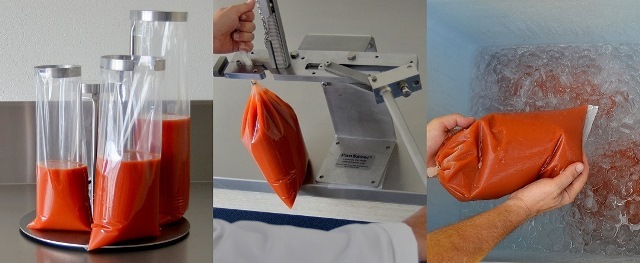Pac Food Cook Chill Bags
Pac Food’s Cook Chill Bags are specially designed high gauge bags with extra barrier to extend shelf life.
The Cook Chill Bags are tubular with two seals on the bottom, 115 micron thick. These bags are also known for being excellent boil in bags.
The basics of the cook chill method:
- Hot Fill Cook Chill Bags (up to 95°C) with wet dishes (soups, sauces etc.) by hand scooping, pump filling or vertical form filling
- Seal the bags (using a clip seal or heat seal)
- Chill the bags and content, using an ice bath, blast chiller or tumble chiller
- Store the bags in a cold room, ideal temperature 0-2°C
- Regenerate in a steam oven (up to 95°C) or boiling water
The basic idea behind Cook Chill is that bacteria are brought through the Food Temperature Danger Zone very quickly to avoid growth. This will achieve a longer shelf life of your wet dishes. Instead of making your soups or sauces every day, you can now make them once a month in larger volumes. This means buying ingredients in larger quantities for lower prices, which means cleaning your kitchen only once etc. Economy of scale is what we are talking about.
What is Temperature Danger Zone?
As the name suggests, the danger zone refers to the most dangerous temperature for foods, between 4°C and 60°C. This range of temperature is dangerous because it’s below the temperature at which heat destroys bacteria (above 60°C), yet above the cooling range (below 4°C) where the growth of bacteria is slowed.
A single bacterium can multiply to thousands in just twenty-four hours when between 4°C and 60°C. This is because bacteria double approximately every twenty minutes under the right conditions: food, moisture, oxygen and warm temperature. Many foods, with their rich supply of nutrients and moist quality, offer the perfect environment for bacteria to grow.
For more information, visit the Pac Food website.
You may also like
-
Stay up to date with the latest news, industry insights and foodpro updates.
- Subscribe


